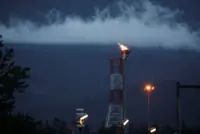Researcher Elisabeth Gerster squats next to several cows in farmer Gerold Mohr’s barn. She and her team are studying the effects of different types of feed on the animals. Photo: dpa
When cow number 121 belches, scientist Elisabeth Gerster takes a very close look at her lunch.
The dairy cow is part of farmer Gerold Mohr’s herd. When she’s given concentrated feed, scientists measure how much methane the cow produces later.
Already a subscriber? Log in
Save 30% OFF The Star Digital Access
Cancel anytime. Ad-free. Unlimited access with perks.





